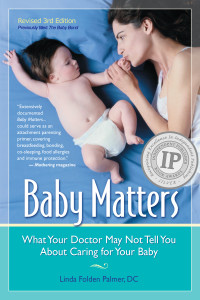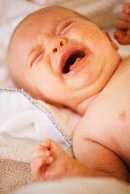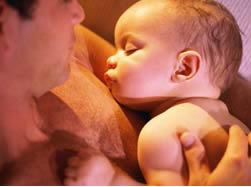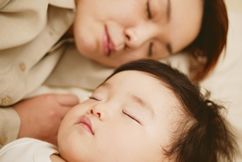A Review of the Studies – Part 1
Because the AAP, baby product industry, and media want you to hear only the sensationalized incomplete findings.
by Linda Folden Palmer, DC
Author “BABY MATTERS“
GO TO PART 2
OCTOBER 2005
Reviewing study after study, the message is clear: The relative risk of death for infants habitually sleeping in a safe adult bed with a safe parent is not greater than those found sleeping next to the parental bed, and their death risk is far smaller than those sleeping in a crib in another room. And, for infants over 2 or 3 months of age, the studies show co-sleeping as safe or safer than sleeping next to the parental bed.
 Just as they once were in cribs, suffocation risks are apparent on adult surfaces. The clear message should be that the adult bed needs to be made safe without overly fluffy or heavy bedding, wedging dangers, overheating, siblings (with a very young infant), or drugged or drunk parents or parents who smoke. Sofa sleeping is not safe with babies, nor is impromptu cosleeping in those not accustomed to it. The message we get from the AAP? Cosleeping is unsafe. Period. While breastfeeding is shown to reduce SIDS, breastfeeding is not mentioned, and interventions that can impede breastfeeding are promoted without appropriate substantiation.
Just as they once were in cribs, suffocation risks are apparent on adult surfaces. The clear message should be that the adult bed needs to be made safe without overly fluffy or heavy bedding, wedging dangers, overheating, siblings (with a very young infant), or drugged or drunk parents or parents who smoke. Sofa sleeping is not safe with babies, nor is impromptu cosleeping in those not accustomed to it. The message we get from the AAP? Cosleeping is unsafe. Period. While breastfeeding is shown to reduce SIDS, breastfeeding is not mentioned, and interventions that can impede breastfeeding are promoted without appropriate substantiation.
Unfortunately, no studies bother to derive from their statistics a risk ratio for deaths of babies co-sleeping in a family bed with safe, non-smoking, sober parents and with reasonable efforts to reduce wedging and other suffocation dangers. From the available statistics, the full number can only be guessed at, but is clearly as safe or safer than the child sleeping in a crib in the same room as parents and, of course, far safer than sleeping in a crib in another room. Contradictory to the supposed goals of the AAP, it is clear that limiting safe cosleeping will not reduce SIDS.
It is important to understand the use of quoted stats in the news…
When you hear these terms in the news:
The term “adult bed” usually includes dangerous sofas, sofa chairs, make-shift beds, and waterbeds, which account for a large portion of the adult-surface deaths. Also, it doesn’t necessarily mean there is cosleeping. An infant sleeping alone on an adult bed is at greater risk than when with a protective parent. The use of such terms wrongly makes appropriate adult bed sharing sound dangerous.
“Bedsharing/cosleeping” statistics and comments usually include sleeping with any adult in any state (including over-exhausted, drunk, or drugged), with a smoking adult, or with another child, or multiples of these; and includes dangerous sofa sharing etc. ALSO, usually statistics are for having co-slept at any time during the night of death — not necessarily cosleeping at the time of death. Conscientious parents are scared away from safe cosleeping by such slanted reporting.
Notice that most studies lump all unexpected infant deaths as SIDS and some pose suspected suffocations as distinct from SIDS. The resultant stats will be quite different. While co-sleeping may reduce actual SIDS, the suffocation risks alone are greater for bed-sharing, (as great as they used to be in cribs before safety standards were taught), when appropriate precautions are not taken, and mostly with the tiniest infants or those with neurological impairment.
Additionally, a new risk-association with infant death in bedsharing is pointed out in a few studies that looked for it: the finding that possibly half of those dying while bedsharing were not accustomed to bedsharing, meaning, among other possibilities, that the parents or whomever were not experienced in protecting the baby from hazards, that the bedsharing was impromptu due to overtired or intoxicated parents, or that the baby may have had extra fussiness for some health reason and was brought to the parental bed for that reason.Why do no studies fully compare safe, customary, conscientious cosleeping with other sleep situations? The results would reveal the safety and benefits of the family bed.
The numbers in the largest study on cosleeping around the world suggest that safe cosleeping reduces SIDS! Most nations with SIDS rates much lower than the United States regularly practice cosleeping, on firm surfaces. See graph on next page.
Below are my summaries of key points from the largest and most-recent studies; a large portion of which come from the AAP’s own journal, Pediatrics, and including all of the relevant studies referenced in the big October 2005 journal announcement (or more-current reports from the same studies or authors).
Because the AAP, baby product industry, and media want you to hear only the sensationalized incomplete findings, I demonstrate what the studies truly found.







M. Lahr et al.,“Bedsharing and Maternal Smoking in a Population-Based Survey of New Mothers” Pediatrics (U.S.) 116, no. 4 (Oct 2005): e530-42.
At the face, this is a study of smoking and cosleeping using 1867 women in Oregon, yet in this October 2005 study — in the issue just before that containing the big AAP announcement warning against all cosleeping — andpublished in the journal of the AAP:
The MD and PhD authors extensively analyze 9 large case-control studies of bedsharing and SIDS and additionally review several other studies as well.
These authors state that “Recommendations must be based on solid scientific evidence, which, to date, does not support the rejection of all bedsharing between nonsmoking mothers and their infants.“






L. Knight et al.,“Cosleeping and Sudden Unexpected Infant Deaths in Kentucky” The American Journal of Forensic Medicine and Pathology (U.S.) 26, no. 1 (Mar 2005): 28-32.
Knight and co-authors examine 697 sudden unexpected infant deaths in Kentucky from 1991 to 2000.
43% of co-sleeping deaths occurred on sofas (36%) or waterbeds (7%). A large portion of dying co-sleepers were sleeping with siblings, “disinterested caregivers,” and other inappropriate partners, or in over-crowded beds.
The authors opine upon their analysis that cosleeping itself is perhaps not dangerous but death risks are related to unsafe cosleeping environments,including unsafe sleep partners and partners who smoke, and unsafe surfaces and bedding.






E. Mitchell et al., “Risk Factors for Sudden Infant Death Syndrome Following the Prevention Campaign in New Zealand: A Prospective Study” Pediatrics (New Zealand) 100, no. 5 (Nov 1997): 835-40.
232 New Zealand SIDS cases between 1991 and 1993 and 1200 control cases are examined for risk factors.
No increased risk of SIDS was found when bedsharing with a non-smoking mother.
There was a 31% increased risk of SIDS for NOT breastfeeding (after considering modifiable risk factors. Raw figure was 67% increased risk.)









H. Klonoff-Cohen and S. Edelstein, “Bed Sharing and the Sudden Infant Death Syndrome” British Medical Journal (England) 311, no. 7015 (Nov 11, 1995): 1269-72.
200 infants dying of SIDS in Southern California and 200 control infants were studies to measure whether infants bedsharing with their parents were more likely to die from SIDS than other infants.
45 of the 200 infants died while cosleeping: 35 sharing their parents’ bed, 6 sharing a babysitter’s bed, and 4 died while sleeping in their mother’s arms (this was included as cosleeping). This represents 22.5% of the total SIDS deaths as occurring during cosleeping: a number similar to or likely lower than thenumber of infants usually cosleeping. Smoking, drug use, and medical conditions were accounted for statistically.
The authors reported that there was “no significant relation between routine bed sharing and the sudden infant death syndrome.“
P. Blair et al., “Babies Sleeping with Parents: Case-Control Study of Factors Influencing the Risk of Sudden Infant Death Syndrome. CESDI SUDI Research Group” British Medical Journal (England) 319, no. 7223 (Dec 4, 1999): 1457-61.
This study looks at 325 babies who died of SIDS, including suffocation deaths, around England from 1993 to 1995, along with 1300 matched controls.
The highest risk of SIDS in this study, like most, was sharing sofa sleeping, at49 times the risk (same number as Unger et al.) of sleeping alone in the parent’s room.
The second highest risk for SIDS in this study was sleeping outside of the parental room, with 10.5 times the risk of sleeping in the parent’s room.
37% of the control bedsharers (4 matched live controls for every SIDS infant)slept between their parents (suggesting this is the normal rate for this) while only 22% of infants dying in bed with a parent or parents were found betweenthe parents at time of death — contradicting Unger’s implied factor of added danger in having the father in bed.
Sharing the parental bed at the last sleep was found to be safer than sleeping in another room, but still nearly 10 times the risk of sleeping alone in the parental room. This is the highest reported factor among studies, however:
After the authors removed risk factors such as prone sleeping, being placed on a pillow, being found with head covered, smoking, alcohol, parental tiredness, overcrowded situations, and pacifier use, (which was considered a risk factor in this study),the risk of bedsharing at last sleep was 1.35 times (or 35% higher than) that of being next to the bed; a number which the authors referred to as statistically not significant for the strength of their figures. Still, wedgingdeaths from un-prepared beds, usually a considerable factor, waterbed usage, and parental drug usage, were apparently not removed from this value. These are all modifiable factors. Also not reported is how many of these were actually in the adult bed at time of death, rather just there for some time during their last night.
Drug usage and other such factors tend to represent the difference between conscious, conscientious family-sleep-sharing, and co-sleeping of convenience or by default.
Excluding infants under 14 weeks of age, the risk of sharing with parent or parents was 1.08 times that of lone sleeping in the parental bedroom, beforewedging, drugs, and other factors are taken into consideration.








P. Blair et al., “Sudden Infant Death Syndrome and Sleeping Position in Pre-Term and Low Birthweight Infants: An Opportunity for Targeted Intervention” Archives of Disease in Childhood (England) epub ahead of time: 10.1136/adc.2004.070391 (May 24 2005).
This paper is a continued and extended evaluation of the CESDI SUDI study above, with 325 case infants and 1300 controls; this time looking at the aspect of infant size at birth. This study, like most, includes suffocation deaths in the term SIDS.
The calculated odds of SIDS for being small at birth (pre-term or low birth weight) and bed-sharing with a smoking parent is 37 times the risk of a full-sized term infant sleeping alone in the parental room.
For those born small, co-sleeping with a non-smoking parent posed aquadrupled risk of SIDS versus sleeping alone near the parental bed. Other risk factors are not removed from this statistic, but clearly the tiniest are vulnerable to suffocation and overheating complications when not well prevented.
Those who were not small at birth, and were cosleeping with parents who don’t smoke had only 4/5ths the risk of dying of SIDS as those not-small infants sleeping next to the parental bed.
As in other studies, when measured, a protective effect of cosleeping is shown statistically beyond the first 2 or 3 months, or a certain weight, before other risk factors are even accounted for.
Full-sized infants cosleeping with a smoking parent showed nearly 8 times the risk is SIDS as sleeping alongside non-smoking parents.






L. Li et al., “Investigation of Sudden Infant Deaths in the State of Maryland (1990-2000)” Forensic Science International (U.S.) 148, no. 2-3 (Mar 10, 2005): 85-92.
While causes of deaths for 1619 Maryland infants during 1990-2000 are examined, 930 infants comprised of 802 SIDS infants plus 128 accidental infant deaths, (including suffocations), are evaluated for sleeping locations.
33% of SIDS cases were bed sharing with any kind of partner(s). (So what percentage of all infants are bed-sharing?)
An additional 1.6% of the total SIDS plus accidental death cases were diagnosed as overlain. The literature commonly recognizes a likely overdiagnosis of overlaying resulting from opinions on cosleeping. While only 1/3rd of these had physical evidence of suffocation, such evidence is commonly not found in many kinds of suspected suffocations.
45% of SIDS were found alone in cribs.
An additional 3% died from defective cribs. (Double the suspected overlayings).







R. Carpenter, P. Blair, P. Fleming et al., “Sudden Unexplained Infant Death in 20 Regions in Europe: Case Control Study” Lancet (England) 363, no. 9404 (Jan 17, 2004):185-91.
20 European regions were covered during the years of 1992 to 1996 totaling in 745 SIDS cases, including suffocation cases, and 2411 controls.
Bed sharing with a non-smoking mother was shown to have 1.5 times the risk as not bed sharing but in the same room, before any other risk factors were removed from the statistic, such as unsafe bedding, drugs, alcohol (which more than doubled risk), infant not accustomed to bed-sharing, etc.
Any of this small statistical risk of bed sharing, with non-smoking mothers but under any other risk factor, was only significant for infants under 8 weeks of age. As pretty much seen across the board, once suffocation risk from inappropriate practices is out of the picture, cosleeping becomes safer than not.
Bed sharing with a smoking mother was 18 times the risk.
No increase in infant deaths was found when mother had 1 to 2 alcoholic drinks, versus none, but when mother had 3 or more drinks, the risk of infant death, (alcohol risk only found when cosleeping), was 2.3 times the risk of sleeping with a non-drinking mother. Although drinking statistics were obtained, the risk for bedsharing with a non-smoking and non-drinking mother was not reported.









B. Unger, J. Kemp et al., “Racial Disparity and Modifiable Risk Factors Among Infants Dying Suddenly and Unexpectedly”Pediatrics (U.S.) 111, no. 2 (Feb 2003): 127-131.
This study looked at all deaths under age 2 years in St Louis County from 1994 through 1997, totaling 119 deaths of SIDS, accidental suffocation, or undetermined causes. The question as to why the rates of such unexplained infant deaths are several times higher in African Americans than in other Americans was addressed.
21% of African American (AA) sudden and unexpected infant deaths and 54%of non-African American deaths occurred in cribs.
23% of “bedsharing” AA deaths occurred while sharing sleep with another individual on a sofa; and 9% so in non-AA. (Sofa sleeping is always found statistically to be extremely unsafe) — Sofas are generally referred to as adult surfaces or “bed-sharing” in most other studies — misleading parents into fearing bedsharing when sofa and chair sharing are major factors. When sofa deaths include sharing with another individual in other studies, this is termed co-sleeping and is lumped in with all cosleeping deaths. Only the most current studies attempt to separate these components.
The risk of SIDS for “bedsharing” on a sofa was 49 times the risk of not-bedsharing.
33% of AA cosleeping deaths and 18% of non-AA were when sharing with siblings — another well-known risk factor for tiny infants.
The great majority, (percentage undeterminable), of deaths outside of cribsincluded modifiable risk factors such as inappropriate or overly soft bedding, sofa sleeping, or drunk mother or otherwise inappropriate sleeping partner(s). Smoking was not taken into account in this study.
Only 15% of all AA (67% of total were sharing X 23% of those who did share) and 3.5% of non-AA (35% of total were sharing X 10% of those who shared) unexpected infant deaths occurred on an adult bed with his or her mother alone* — and the majority of these still included other known risk factors.
41% of African American babies in St. Louis bedshare. (No non-AA rate was provided.)
* Additional number in attendance by the father is not provided in study but his presence is usually not statistically contra-indicated.
– Part 1 – >> Go To Part 2


[…] PART 2 GO TO PART 1 […]
My point Exactly! 🙂